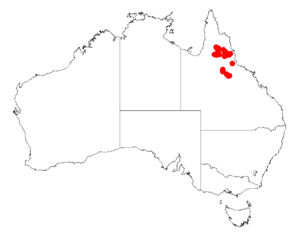Acacia meiosperma facts for kids
Quick facts for kids Acacia meiosperma |
|
|---|---|
| Scientific classification | |
| Genus: |
Acacia
|
| Species: |
meiosperma
|
 |
|
| Occurrence data from AVH | |
Acacia meiosperma is a type of shrub or tree. It belongs to the Acacia family, which is a large group of plants. This plant is originally from the northeastern part of Australia.
What it Looks Like
This shrub or tree usually grows to be about 2 to 3 meters (6 to 10 feet) tall. Its branches are smooth and have a sticky, resin-like feel.
Like many Acacia plants, it doesn't have regular leaves. Instead, it has special flattened stems called phyllodes. These phyllodes are smooth and shaped like a narrow oval. They can be straight or slightly curved. Each one is about 7 to 12.5 centimeters (3 to 5 inches) long and 2 to 3 centimeters (about 1 inch) wide. They have a few clear veins and many tiny, close veins.
The plant produces groups of one to four flower spikes. These spikes grow where the phyllodes meet the stem, which is called the axil. The flower spikes are about 1.5 to 3.5 centimeters (0.6 to 1.4 inches) long. They are full of bright golden flowers.
After the flowers bloom, flat, smooth, and leathery seed pods grow. These pods are long and thin, up to 8 centimeters (3 inches) long and about 3 millimeters (0.1 inches) wide. They have faint ridges running along them. Inside, the seeds are shiny and brown with a yellow center. They are oblong-shaped, about 3 to 4 millimeters (0.1 to 0.2 inches) long. Each seed has a creamy white, folded attachment called an aril.
Where it Grows
Acacia meiosperma is found only in a small area of Queensland, Australia. This special plant grows about 40 kilometers (25 miles) southeast of a town called Chillagoe. It often grows in groups on plains and slopes. You can find it in shallow, rocky soils.

